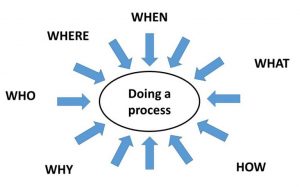Systemic processes are central to my approach to systems thinking.
Everything – every object – exists in time. Therefore every object has a life cycle and is a process. But the process is set in the context of a system containing other connected processes – some at higher and some at lower levels of definition. We capture those processes using mind maps to create a processs model.
All processes have attributes that we characterise using why, how, who, what, where, when.

Why attributes include all expressions of sucess as purpose including vision, mission, objectives and targets.
How attributes include all models of transformations of inputs to outputs, including physical systems (scientific) models, method statements, systems models, resources requirements
Who attributes include all of the people involved – the players or actors- and their roles and functions. In particular the process owner is the leader responsible for the delivery of success to the client(s) and keeping all stakeholders informed of progress.
What attributes include all expressions (models) of structure and form, state variables, performance indicators, inputs and outputs as well as Italian Flags or any other summary measures of progress or performance.
Where attributes include definitions of systems boundaries, contextual assumptions as well as physical site or place as location.
When attributes include durations and times such as earliest/latest start, earliest/latest finish, float from e.g. a critical path network analysis.
These variables manifest tyemselves in physical hard systems as in the table below.
| Physical hard System | Potential
(Why) |
Flow
(What) |
Impedance
(What) |
| Electricity | Volts | Amps | Resistance, capacitance, inductance |
| Mechanics | Velocity | Force | Damping, mass, flexibility |
| Water pipes | Pressure head | Flow | Drag, open tanks/reservoirs, closed tank? |
| Traffic | Need | Flow | On-street parking, off-street parking, route changes |
| ‘Soft’ | Why – | (Who, | Ambiguity/conflict, |
| creative | What, | capacity to perform, | |
| tension | Where,
When) |
capacity to adapt/innovate |
We can compare some hard system derivatives with speculative soft ones as in table below
| Concept | Hard – e.g. Mechanics | Soft – suggested equivalent |
| Across Variable: Potential V
(Why) |
Velocity | Motivation: The rate of change of willpower (self-control): volition for purposeful effective action |
| Through Variable: Flow q
(Who, What) |
Force | Rate of external change through action |
| Integrated V: x = ∫Vdt | Displacement | Will: strength of purpose |
| Differentiated V: y = dV/dt | Acceleration | Increasing motivation |
| Integrated q: z = ∫qdt | Momentum | Change |
| Power P = Vq | Power | The capacity to influence change: authority, means, competence, capability, proficiency |
| Work W = ∫qdx | Effort | Effort |
| Energy E = ∫Pdt | Capacity for work | Capacity for work |
| Capacitance | Mass, inertia | Ambition, aspiration, resoluteness as stored willpower |
| Inductance | Flexibility | Adaptability to change |
| Resistance | Damping | Prevarication and wasted effort |
To most people a handbag is an object with ‘substance’ (the materials with which it was made) and form with some sense of permanence. To a systems thinker of the type we are describing here a handbag is a process that plays a role in other processes. Put at its simplest, the handbag has a life cycle in which it was conceived, designed, made and used and eventually disposed of. Whatever it was designed to do (function) and whatever form it takes (e.g. as a fashion item) it is unlikely that it was designed to carry an abandoned baby as in the play ‘The Importance of Being Ernest’ by Oscar Wilde premiered in 1895 . Nevertheless in that role or function the handbag played a crucial part in keeping the infant Jack safe and, as revealed as the play unfolds. The handbag was important in his being abandoned, found and rescued and taken into a good family upbringing.
To understand what we mean here when we refer to a process we need to reject all existing preconceptions of what constitutes a process and to create a new and all encompassing definition. So a new process is not just the how of doing as it is often used. It is not just an input being transformed to an output, or a Gantt bar chart, a recipe, a flowchart, a network of an IDEF0 diagram – it is all of these and more.
It is our contention that we can capture everything that we know (model) in processes. A handbag, a kettle, a building, an aeroplane, a power station, an airport terminal and all living things, including human beings, can all be represented as processes. In this way a systems thinker recognises from the start that everything has life cycle. But it is a life cycle that is set in the context of a system containing other processes – some at higher and some at lower levels of definition.
